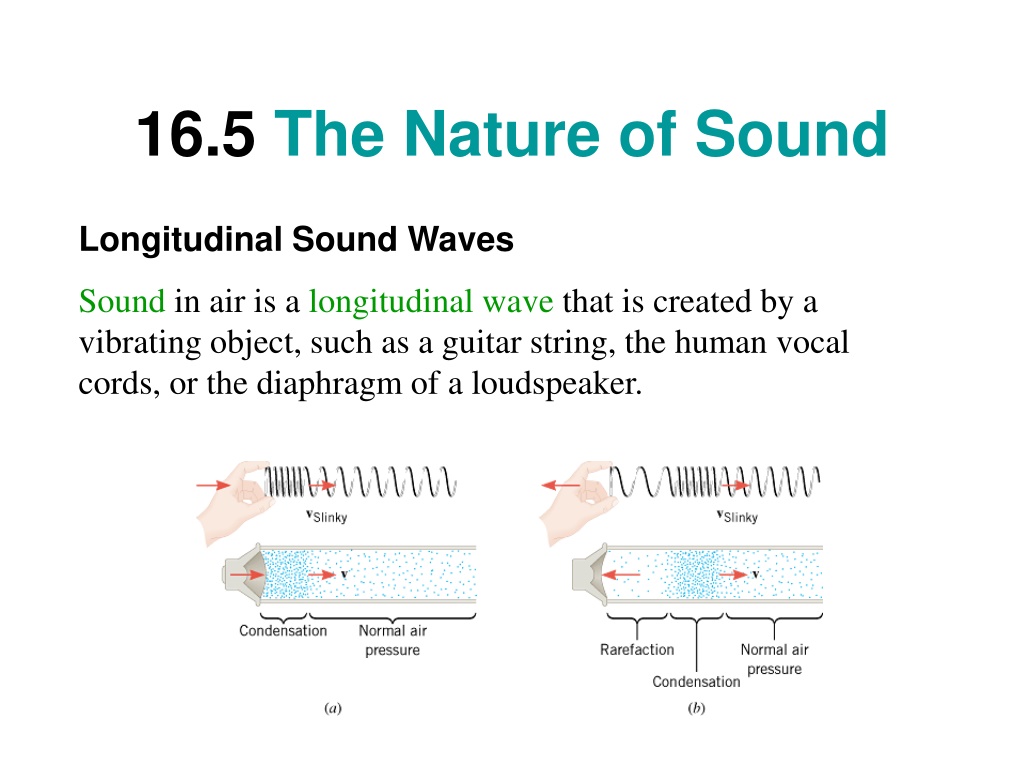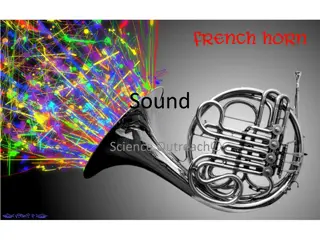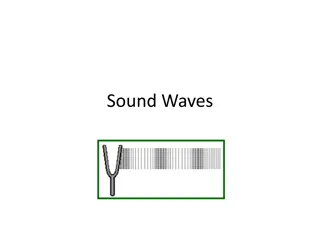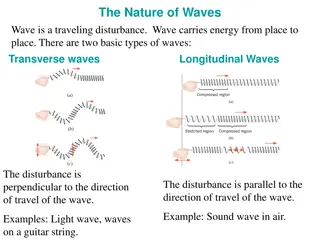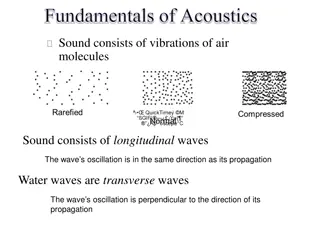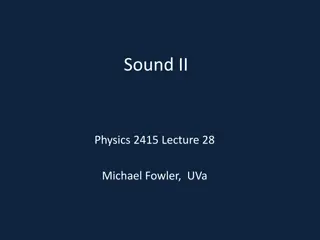Understanding Sound Waves: Nature, Properties, and Characteristics
Sound waves are longitudinal waves created by vibrating objects in air. They cannot propagate in a vacuum. Understanding how we hear involves exploring wave representations and the frequency ranges of sound waves, from infrasonic to ultrasonic. Sound also exhibits objective and subjective properties, such as frequency, pitch, intensity, and waveform. The speed of sound varies in different mediums, impacting its propagation. This comprehensive guide delves into the various aspects of sound waves, including their creation, properties, and effects.
Download Presentation

Please find below an Image/Link to download the presentation.
The content on the website is provided AS IS for your information and personal use only. It may not be sold, licensed, or shared on other websites without obtaining consent from the author. Download presentation by click this link. If you encounter any issues during the download, it is possible that the publisher has removed the file from their server.
E N D
Presentation Transcript
16.5 The Nature of Sound Longitudinal Sound Waves Sound in air is a longitudinal wave that is created by a vibrating object, such as a guitar string, the human vocal cords, or the diaphragm of a loudspeaker.
Sound cannot propagate in a vacuum Bell in a vacuum
Graphic representations of a sound wave. Air at equilibrium, in the absence of a sound wave; Compressions and rarefactions that constitute a sound wave; Transverse representation of the wave, showing amplitude (A) and wavelength ( ). Name the x axis? What are the choices for the y-axis? Draw a transverse representation of a wave, name the axes, and show period.
The Frequency of a Sound Wave Audible Range: 20 Hz ----- 20,000 Hz. Infrasonic waves: Sound waves with frequencies < 20 Hz. Rhinoceroses use infrasonic frequencies as low as 5 Hz to call one another Ultrasonic waves: Sound waves with frequencies > 20,000 Hz. Bats use ultrasonic frequencies up to 100 kHz for locating their food sources and navigating.
Objective and Subjective properties of sound Objective properties can be measured, used in physics. Subjective properties are subjective to the person, used in music. Objective property Subjective quality Frequency Pitch Intensity Loudness Waveform Tymbre or Quality
Speed of Sound in an ideal gas = 1.40 (ratio of specific heats for air) m = 4.8 x 10-26 kg (average molecular mass of air) k = 1.38 x 10-23 J/K (Boltzmann constant) T= temperature in Kelvin kT = v m Gases Speed of Sound (m/s) Liquids Speed of Sound (m/s) Solids Speed of Sound (m/s) Air (0 C) 331 Chloroform (20 C) 1004 Copper 5010 Air (20 C) 343 Ethyl alcohol (20 C) 1162 Glass (Pyrex) 5640 Carbon dioxide (0 C) 259 Mercury (20 C) 1450 Lead 1960 Oxygen (0 C) 316 Fresh water (20 C) 1482 Steel 5960 Helium (0 C) 965 Seawater (20 C) 1522
16.7 Sound Intensity The sound intensity I is defined as the sound power P that passes perpendicularly through a surface divided by the area A of that surface: The unit of sound intensity is power per unit area, or W/m2.
Human Ear and Sensitivity Audible frequency range: 20 Hz 20,000 Hz Audible intensity range: 10 12 W/m2 - 10 w/m2 10 12 W/m2 = Threshold of hearing 10 W/m2 = Threshold of pain
16.8 Decibels The decibel (dB) is a measurement unit used when comparing two sound intensities. The intensity level (expressed in decibels) relative to the threshold of hearing, Io is defined as follows:
Typical Sound Intensities and Intensity TABLE 16.2 Levels Relative to the Threshold of Hearing Intensity Level (dB) Intensity I (W/m2) Threshold of hearing 1.0 10-12 0 Rustling leaves 1.0 10-11 10 Whisper 1.0 10-10 20 Normal conversation (1 meter) 3.2 10-6 65 Inside car in city traffic 1.0 10-4 80 Car without muffler 1.0 10-2 100 Live rock concert 1.0 120 Threshold of pain 10 130
